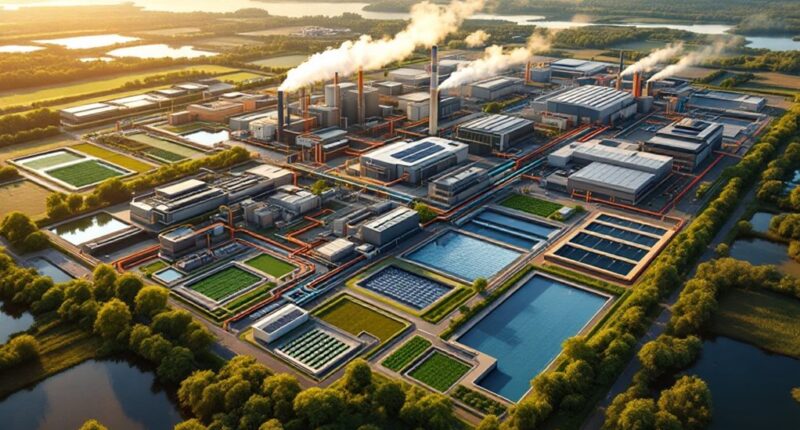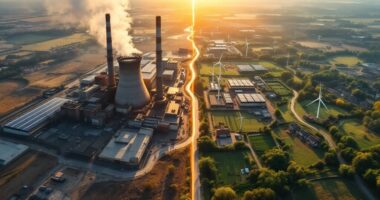Industrial ecology transforms traditional manufacturing by treating waste as valuable resources. This approach mirrors natural ecosystems, where nothing is truly wasted. Companies in places like Kalundborg, Denmark exchange byproducts, saving money while reducing environmental impact. The concept involves engineers, economists, and scientists collaborating to create closed-loop systems that optimize material and energy flows. Despite regulatory challenges, this framework offers both economic advantages and environmental benefits for those willing to embrace its circular principles.

Nature’s elegant efficiency meets human innovation in the domain of industrial ecology, a revolutionary approach to reimagining our production systems. Coined in 1989 by Robert Frosch and Nicholas Gallopoulos, this field examines how we might transform our linear “take-make-waste” industrial processes into circular systems that mimic natural ecosystems. It’s like teaching our factories to function like forests – where one organism’s leftovers become another’s lunch.
Industrial ecology is a multidisciplinary playground where engineers, economists, sociologists, and toxicologists gather to solve a common puzzle: how to create closed-loop industrial systems. The concept of industrial metabolism sits at its core – analyzing material and energy flows with the attentiveness of a nutritionist tracking calories, but with higher stakes and fewer guilt trips. This scientific approach helps quantify resource usage and environmental impacts through rigorous material flow analysis methodologies.
The applications are as diverse as they are impressive. At Kalundborg in Denmark, companies swap waste like kids trading baseball cards – except what they’re exchanging is steam, gypsum, and other byproducts that would otherwise be trashed. In Nanjangud, India, industries have achieved a mind-boggling 99.5% waste reuse rate – putting your household recycling efforts into humbling perspective. Implementing resilient design principles helps these systems withstand climate-related disruptions while maintaining their circular function.
These circular approaches deliver environmental benefits that would make Mother Nature blush with pride: reduced greenhouse emissions, conserved resources, and minimized waste. But here’s the kicker – what’s good for the planet is also good for profit margins. Companies save on raw materials, dodge waste disposal fees, and open new revenue streams by selling their “waste” as someone else’s treasure. The development of sophisticated water treatment systems has been crucial in minimizing industrial pollutants before they enter natural water bodies, supporting the closed-loop vision of industrial ecology.
Of course, challenges remain. Scaling these principles requires overcoming regulatory hurdles that make the Olympic steeplechase look simple. Developing technologies for efficient material recovery sometimes feels like trying to unscramble an egg.
But as industrial ecology principles gradually infiltrate business practices and urban planning, we’re witnessing the early stages of an industrial revolution that might actually leave the planet better than we found it.
Frequently Asked Questions
How Does Industrial Ecology Differ From Traditional Environmental Management Approaches?
Industrial ecology differs from traditional approaches by taking a holistic systems view rather than focusing on isolated problems.
It examines material and energy flows across entire industrial networks, emphasizing prevention through design rather than end-of-pipe solutions.
While traditional methods often address pollution after it occurs, industrial ecology promotes inter-industry collaboration, waste exchange networks, and closed-loop systems that mimic natural ecosystems.
It adopts a thorough life-cycle perspective rather than addressing single-point environmental impacts.
What Role Do Consumers Play in Industrial Ecology Systems?
Consumers are pivotal players in industrial ecology systems through their purchasing decisions, usage patterns, and disposal behaviors. They drive material flows by demanding certain products, determine product lifespans through maintenance choices, and influence recycling systems through waste sorting practices.
Their awareness of environmental impacts shapes market demand for sustainable alternatives. Fundamentally, consumers function as both the beginning and endpoint of material cycles, creating feedback loops that can either reinforce or transform production systems.
Can Industrial Ecology Concepts Apply to Service-Based Businesses?
Industrial ecology concepts absolutely apply to service-based businesses.
Services can map their resource consumption patterns, analyze digital data as virtual materials, and quantify waste from operations. They can implement dematerialization strategies, optimize energy efficiency, and design for extended responsibility.
Service sectors can create symbiotic relationships through shared ecosystems and collaborative consumption models. Digital platforms enable resource sharing while performance-based business models support circular economy principles.
Even without physical products, services create material and energy flows ripe for ecological optimization.
How Are Industrial Symbiosis Networks Initiated and Maintained?
Industrial symbiosis networks typically begin with economic drivers, where companies recognize mutual benefits in resource exchanges.
Anchor companies often initiate relationships, while facilitators identify opportunities and broker connections.
Networks thrive when participants establish trust, develop shared infrastructure, and maintain open communication channels.
Digital platforms increasingly support these ecosystems by mapping material flows and connecting potential partners.
Government policies and incentives can catalyze development, though regulatory barriers and market uncertainties remain persistent challenges.
What Metrics Measure the Success of Industrial Ecology Implementations?
Success metrics for industrial ecology implementations span four key dimensions.
Resource efficiency metrics track material, energy, and water intensity plus recycling rates.
Environmental impact metrics measure carbon footprint, waste generation, and ecosystem effects.
Economic performance metrics evaluate cost savings, by-product revenue, and ROI.
System-level metrics assess industrial symbiosis linkages, circularity indices, and policy effectiveness.
Together, these metrics provide an all-encompassing view of how well material and energy flows are being optimized across industrial systems.









